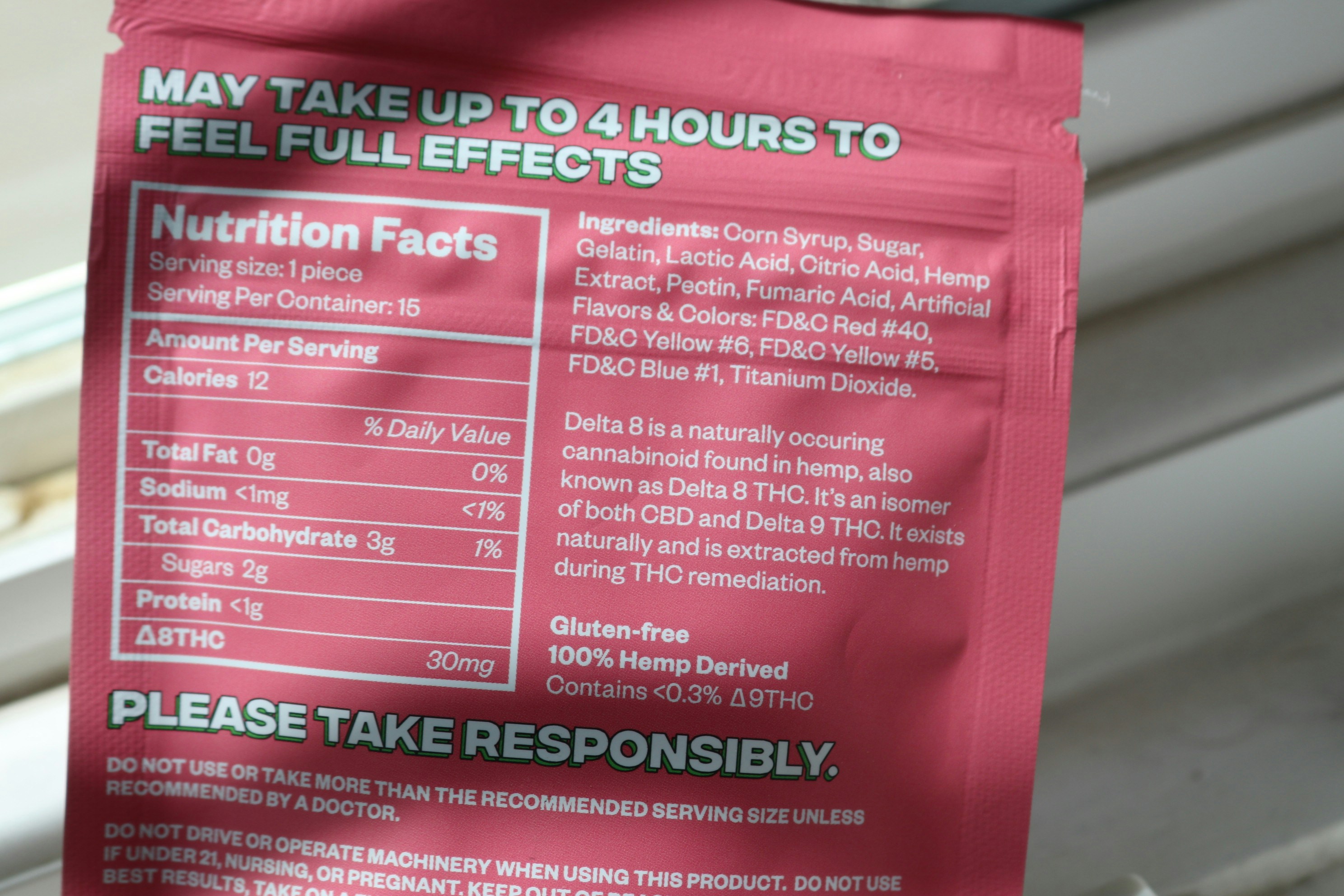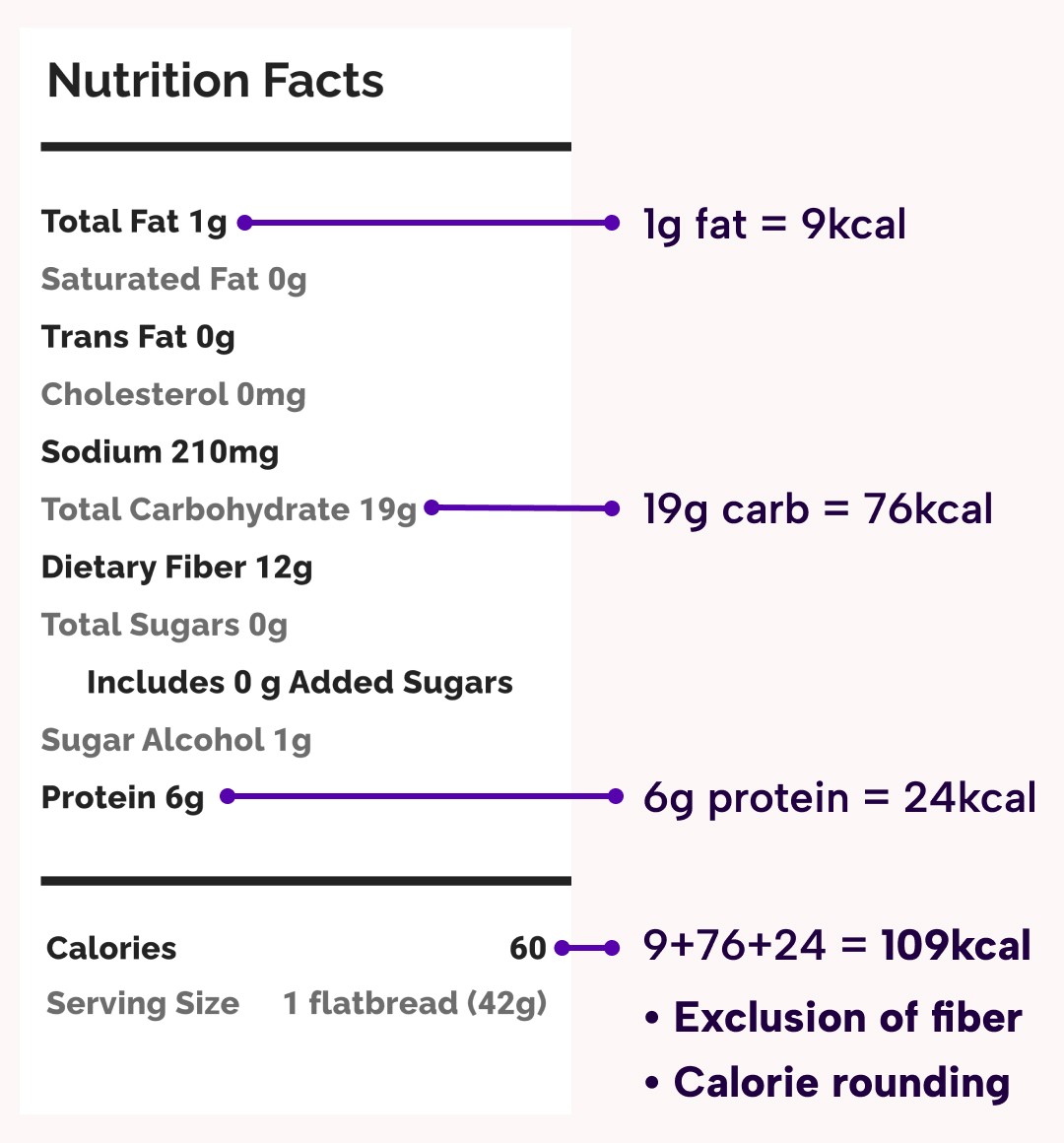


Making Sense of Nutrition Labels
Last updated: Mar 19, 2024
Nutrition
Nutrition labels are valuable tools for making informed food choices but can often be confusing and overwhelming. Let's explore the intricacies of nutrition labels and their common pitfalls and discover how Amelia's methodology offers a balanced and user-friendly alternative, prioritizing overall wellness over stringent calorie counting.
How to Read Nutrition Labels
Let's start with the fundamentals. A typical nutrition label includes:
Serving Size: This is the amount of food on which the nutrient information is based. Be mindful of serving sizes; they are often smaller than you expect.
Calories: The amount of energy the food provides per serving.
Macronutrients: Nutrition labels break down the three macronutrients: carbohydrates, proteins, and fats. As discussed in "The Science of Weight Loss and Macronutrients," each macronutrient plays a unique role in your body.
Micronutrients: These include vitamins and minerals, which are essential for various bodily functions.
Percent Daily Value (%DV): This indicates how much a serving of the food contributes to the recommended daily intake of each nutrient. However, these values are based on a 2,000-calorie diet, which may not be suitable for everyone.
Pitfalls of Nutrition Labels
High margin of error: For macronutrients (carbohydrates, fats, and proteins) and calories, the FDA allows for a margin of error of up to 20% [1]. This means that the actual content of these nutrients can be up to 20% higher or lower than the declared value on the label. For example:
If a product declares 100 calories per serving, the actual calorie content could range from 80 to 120 calories and still be considered compliant with FDA regulations.
If a product declares 10 grams of protein per serving, the actual protein content could be anywhere between 8 and 12 grams.
Calorie Rounding: Manufacturers round calories on nutrition labels for simplicity and compliance with FDA guidelines. The FDA allows rounding to make the information more consumer-friendly and easier to understand. For example, a food product with 96 calories can be rounded to 100 calories.
Misleading Serving Sizes: Serving sizes on nutrition labels can sometimes be misleading, leading to unintentional overconsumption. It's vital to compare the serving size listed on the package with the amount you consume to ensure your dietary intake is accurate.
Exclusion of Fiber in Calorie Counts: While most carbohydrates contribute 4 calories per gram, the FDA allows manufacturers to calculate the caloric value of fiber differently, which can lead to an underestimation of total calories. This discrepancy can be particularly noticeable in high-fiber foods.
Overlooking Alcohol Content: Alcoholic beverages are not required to include a nutrition facts panel [2]. With alcohol providing 7 calories per gram, nearly twice that of carbohydrates and proteins, this missing information can significantly impact your overall calorie intake.
Here's an example of a nutrition label where fiber was excluded, and total calories were rounded.

Amelia's Approach: Simplicity
Amelia is designed to make healthy eating simpler and more enjoyable. While precision is important, for many people, an overly strict focus on numbers can lead to an unhealthy preoccupation with perfection. Amelia strikes a balance between accuracy and ease of use.
Personalized Recommendations: Amelia considers your unique needs and provides personalized recommendations based on factors like your age, gender, activity level, and health goals.
Tracking Made Easy: Amelia emphasizes ease and practicality over perfection. She is designed to guide and support, not to constrain, reflecting a philosophy that health tracking should enhance life, not complicate it.
Alcohol Tracking: Unique in its approach, Amelia tracks alcohol separately from other macronutrients, recognizing its specific effects on the body and its contribution to your caloric intake.
Coaching and Support: Amelia isn't just about tracking; it's about coaching. She offers insights and guidance to help you navigate your nutrition, making healthier choices more straightforward.
Conclusion
Nutrition labels, while valuable, have their pitfalls. From misleading serving sizes to excluding fiber and alcohol calories, these limitations can make it challenging to get a complete picture of your nutritional intake. By understanding these pitfalls and embracing Amelia's personalized, holistic approach, you can make informed food choices without getting overwhelmed by the numbers game.
Remember, the goal is progress, not perfection. With Amelia as your guide, you can develop a healthy, sustainable relationship with food that supports your unique needs and goals. So, the next time you find yourself puzzling over a nutrition label, take a deep breath and trust in Amelia's simple, accurate, and personalized approach to nutrition.
Nutrition labels are valuable tools for making informed food choices but can often be confusing and overwhelming. Let's explore the intricacies of nutrition labels and their common pitfalls and discover how Amelia's methodology offers a balanced and user-friendly alternative, prioritizing overall wellness over stringent calorie counting.
How to Read Nutrition Labels
Let's start with the fundamentals. A typical nutrition label includes:
Serving Size: This is the amount of food on which the nutrient information is based. Be mindful of serving sizes; they are often smaller than you expect.
Calories: The amount of energy the food provides per serving.
Macronutrients: Nutrition labels break down the three macronutrients: carbohydrates, proteins, and fats. As discussed in "The Science of Weight Loss and Macronutrients," each macronutrient plays a unique role in your body.
Micronutrients: These include vitamins and minerals, which are essential for various bodily functions.
Percent Daily Value (%DV): This indicates how much a serving of the food contributes to the recommended daily intake of each nutrient. However, these values are based on a 2,000-calorie diet, which may not be suitable for everyone.
Pitfalls of Nutrition Labels
High margin of error: For macronutrients (carbohydrates, fats, and proteins) and calories, the FDA allows for a margin of error of up to 20% [1]. This means that the actual content of these nutrients can be up to 20% higher or lower than the declared value on the label. For example:
If a product declares 100 calories per serving, the actual calorie content could range from 80 to 120 calories and still be considered compliant with FDA regulations.
If a product declares 10 grams of protein per serving, the actual protein content could be anywhere between 8 and 12 grams.
Calorie Rounding: Manufacturers round calories on nutrition labels for simplicity and compliance with FDA guidelines. The FDA allows rounding to make the information more consumer-friendly and easier to understand. For example, a food product with 96 calories can be rounded to 100 calories.
Misleading Serving Sizes: Serving sizes on nutrition labels can sometimes be misleading, leading to unintentional overconsumption. It's vital to compare the serving size listed on the package with the amount you consume to ensure your dietary intake is accurate.
Exclusion of Fiber in Calorie Counts: While most carbohydrates contribute 4 calories per gram, the FDA allows manufacturers to calculate the caloric value of fiber differently, which can lead to an underestimation of total calories. This discrepancy can be particularly noticeable in high-fiber foods.
Overlooking Alcohol Content: Alcoholic beverages are not required to include a nutrition facts panel [2]. With alcohol providing 7 calories per gram, nearly twice that of carbohydrates and proteins, this missing information can significantly impact your overall calorie intake.
Here's an example of a nutrition label where fiber was excluded, and total calories were rounded.

Amelia's Approach: Simplicity
Amelia is designed to make healthy eating simpler and more enjoyable. While precision is important, for many people, an overly strict focus on numbers can lead to an unhealthy preoccupation with perfection. Amelia strikes a balance between accuracy and ease of use.
Personalized Recommendations: Amelia considers your unique needs and provides personalized recommendations based on factors like your age, gender, activity level, and health goals.
Tracking Made Easy: Amelia emphasizes ease and practicality over perfection. She is designed to guide and support, not to constrain, reflecting a philosophy that health tracking should enhance life, not complicate it.
Alcohol Tracking: Unique in its approach, Amelia tracks alcohol separately from other macronutrients, recognizing its specific effects on the body and its contribution to your caloric intake.
Coaching and Support: Amelia isn't just about tracking; it's about coaching. She offers insights and guidance to help you navigate your nutrition, making healthier choices more straightforward.
Conclusion
Nutrition labels, while valuable, have their pitfalls. From misleading serving sizes to excluding fiber and alcohol calories, these limitations can make it challenging to get a complete picture of your nutritional intake. By understanding these pitfalls and embracing Amelia's personalized, holistic approach, you can make informed food choices without getting overwhelmed by the numbers game.
Remember, the goal is progress, not perfection. With Amelia as your guide, you can develop a healthy, sustainable relationship with food that supports your unique needs and goals. So, the next time you find yourself puzzling over a nutrition label, take a deep breath and trust in Amelia's simple, accurate, and personalized approach to nutrition.
Nutrition labels are valuable tools for making informed food choices but can often be confusing and overwhelming. Let's explore the intricacies of nutrition labels and their common pitfalls and discover how Amelia's methodology offers a balanced and user-friendly alternative, prioritizing overall wellness over stringent calorie counting.
How to Read Nutrition Labels
Let's start with the fundamentals. A typical nutrition label includes:
Serving Size: This is the amount of food on which the nutrient information is based. Be mindful of serving sizes; they are often smaller than you expect.
Calories: The amount of energy the food provides per serving.
Macronutrients: Nutrition labels break down the three macronutrients: carbohydrates, proteins, and fats. As discussed in "The Science of Weight Loss and Macronutrients," each macronutrient plays a unique role in your body.
Micronutrients: These include vitamins and minerals, which are essential for various bodily functions.
Percent Daily Value (%DV): This indicates how much a serving of the food contributes to the recommended daily intake of each nutrient. However, these values are based on a 2,000-calorie diet, which may not be suitable for everyone.
Pitfalls of Nutrition Labels
High margin of error: For macronutrients (carbohydrates, fats, and proteins) and calories, the FDA allows for a margin of error of up to 20% [1]. This means that the actual content of these nutrients can be up to 20% higher or lower than the declared value on the label. For example:
If a product declares 100 calories per serving, the actual calorie content could range from 80 to 120 calories and still be considered compliant with FDA regulations.
If a product declares 10 grams of protein per serving, the actual protein content could be anywhere between 8 and 12 grams.
Calorie Rounding: Manufacturers round calories on nutrition labels for simplicity and compliance with FDA guidelines. The FDA allows rounding to make the information more consumer-friendly and easier to understand. For example, a food product with 96 calories can be rounded to 100 calories.
Misleading Serving Sizes: Serving sizes on nutrition labels can sometimes be misleading, leading to unintentional overconsumption. It's vital to compare the serving size listed on the package with the amount you consume to ensure your dietary intake is accurate.
Exclusion of Fiber in Calorie Counts: While most carbohydrates contribute 4 calories per gram, the FDA allows manufacturers to calculate the caloric value of fiber differently, which can lead to an underestimation of total calories. This discrepancy can be particularly noticeable in high-fiber foods.
Overlooking Alcohol Content: Alcoholic beverages are not required to include a nutrition facts panel [2]. With alcohol providing 7 calories per gram, nearly twice that of carbohydrates and proteins, this missing information can significantly impact your overall calorie intake.
Here's an example of a nutrition label where fiber was excluded, and total calories were rounded.

Amelia's Approach: Simplicity
Amelia is designed to make healthy eating simpler and more enjoyable. While precision is important, for many people, an overly strict focus on numbers can lead to an unhealthy preoccupation with perfection. Amelia strikes a balance between accuracy and ease of use.
Personalized Recommendations: Amelia considers your unique needs and provides personalized recommendations based on factors like your age, gender, activity level, and health goals.
Tracking Made Easy: Amelia emphasizes ease and practicality over perfection. She is designed to guide and support, not to constrain, reflecting a philosophy that health tracking should enhance life, not complicate it.
Alcohol Tracking: Unique in its approach, Amelia tracks alcohol separately from other macronutrients, recognizing its specific effects on the body and its contribution to your caloric intake.
Coaching and Support: Amelia isn't just about tracking; it's about coaching. She offers insights and guidance to help you navigate your nutrition, making healthier choices more straightforward.
Conclusion
Nutrition labels, while valuable, have their pitfalls. From misleading serving sizes to excluding fiber and alcohol calories, these limitations can make it challenging to get a complete picture of your nutritional intake. By understanding these pitfalls and embracing Amelia's personalized, holistic approach, you can make informed food choices without getting overwhelmed by the numbers game.
Remember, the goal is progress, not perfection. With Amelia as your guide, you can develop a healthy, sustainable relationship with food that supports your unique needs and goals. So, the next time you find yourself puzzling over a nutrition label, take a deep breath and trust in Amelia's simple, accurate, and personalized approach to nutrition.
Citations
U.S. Food and Drug Administration. (2020). CFR - Code of Federal Regulations Title 21. https://www.accessdata.fda.gov/scripts/cdrh/cfdocs/cfcfr/CFRSearch.cfm?fr=101.9
U.S. Food and Drug Administration. (2013). Guidance for Industry: Labeling of Certain Beers Subject to the Labeling Jurisdiction of the Food and Drug Administration. https://www.fda.gov/regulatory-information/search-fda-guidance-documents/guidance-industry-labeling-certain-beers-subject-labeling-jurisdiction-food-and-drug-administration
U.S. Food and Drug Administration. (2020). CFR - Code of Federal Regulations Title 21. https://www.accessdata.fda.gov/scripts/cdrh/cfdocs/cfcfr/CFRSearch.cfm?fr=101.9
U.S. Food and Drug Administration. (2013). Guidance for Industry: Labeling of Certain Beers Subject to the Labeling Jurisdiction of the Food and Drug Administration. https://www.fda.gov/regulatory-information/search-fda-guidance-documents/guidance-industry-labeling-certain-beers-subject-labeling-jurisdiction-food-and-drug-administration
U.S. Food and Drug Administration. (2020). CFR - Code of Federal Regulations Title 21. https://www.accessdata.fda.gov/scripts/cdrh/cfdocs/cfcfr/CFRSearch.cfm?fr=101.9
U.S. Food and Drug Administration. (2013). Guidance for Industry: Labeling of Certain Beers Subject to the Labeling Jurisdiction of the Food and Drug Administration. https://www.fda.gov/regulatory-information/search-fda-guidance-documents/guidance-industry-labeling-certain-beers-subject-labeling-jurisdiction-food-and-drug-administration
Stay informed
Sign up for our newsletter to receive wellness content and updates related to Amelia.
Sign up for our newsletter to receive wellness content and updates related to Amelia.
More content



The Power of Protein



Healthy Snacking Options: Ideas for Nutritious and Satisfying Snacks.



Understanding the Impact of Your Menstrual Cycle on Strength Performance



How Menstrual Cycle Impacts on Your Overall Wellness



Your Essential Health and Fitness Guide: Cutting Through the Noise



The Real Scoop on Low-Fat vs. Low-Carb Diets